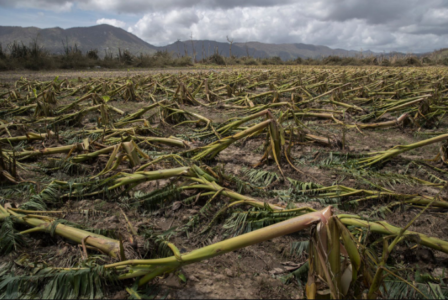Johor farmers face severe crop losses due to erratic weather, with floods followed by intense heat, causing significant disruption to food supply.
Text: JOHOR BAHRU: Farmer Naviin Thiagarajan has traditionally relied on decades-old weather patterns in Malaysia to plan his crop rotations. Working with his father on a 2-hectare farm near Kota Tinggi, the 28-year-old alternates between long beans, okra, and cucumbers, depending on the rainy and dry seasons.
However, Mr. Thiagarajan explained that in recent times, these reliable plans have been thrown into chaos by increasingly unpredictable weather.
“Since last year, we started seeing how unstable the weather has become. And this past month has really highlighted what I’ve read about climate change,” he told CNA.
As 2022 began, parts of Johor were inundated with heavy rain, causing floods that displaced thousands of residents. Many farms were also severely affected, with crops destroyed and farmers’ livelihoods severely impacted.
What has baffled many farmers is how this period of intense rain was quickly followed by unusually hot weather over the last two to three weeks, with significantly less rainfall.
Data from the Johor Department of Irrigation and Drainage indicated that Johor Bahru received 1,448mm of rainfall between Dec 26 and Jan 1. However, in the weeks following, from Jan 1 to Jan 27, rainfall had dropped to 515.3mm, as reported by weather.com. Meanwhile, temperatures increased from an average maximum of 30.6 degrees Celsius to 31.8 degrees Celsius during the same periods.
The northeast monsoon, which typically brings heavy rain from November to March, has been interrupted by this unexpected heatwave, catching farmers off guard.
“The floods destroyed many crops,” Mr. Thiagarajan explained. “But the heat from the last two weeks has been just as devastating. I planted 2,000 cucumbers, and all of them died from the heat.”
While some of his okra and long beans were lost to the December floods, he said the financial impact of the warm weather in January was far worse, estimating that he lost around 10,000kg of cucumbers, worth approximately RM8,000 (US$1,909).
Other farmers in Johor shared similar experiences with CNA. Erratic weather conditions, coupled with the increased demand for fruits and vegetables ahead of Chinese New Year, have caused significant produce shortages.
Durian farmer Mad Zin Abdullah, based in Kampung Tengah in Segamat, saw his December crop wiped out by floodwaters. The roots of many of his trees were destroyed, and he is uncertain if his plantation will recover in time for future harvests.
“The water was chest-deep,” he recalled. “Suppliers were asking for durians, but I had none to sell.”
While the floodwaters have receded, the hot weather that followed has dried out most of his plantation. Despite this, the conditions are still not ideal for crop recovery, with a lack of balance between soil moisture and temperature.
The chairman of the Yong Peng vegetable farmers’ association, Cheng Tai Hoe, reported that around 30 percent of crops in Tangkak and Segamat were destroyed by floods. He explained that the combined effect of flood-damaged roots and prolonged heat has stunted the growth of vegetables like cucumber and bitter gourd.
Farmers are struggling to recover, leading to higher produce prices at local markets and in exports to Singapore. “With many farmers unable to meet demand, prices have risen. Only those who can afford it will be able to buy these vegetables,” Mr. Cheng explained.
Adapting to Climate Change
Environmental expert Renard Siew noted that the situation in Johor aligns with a report from the Intergovernmental Panel on Climate Change (IPCC), which stated that climate change is intensifying the water cycle, resulting in more extreme rainfall and longer droughts.
Dr. Siew, a climate change advisor at the Centre for Governance and Political Studies (Cent-GPS), said Johor’s erratic weather clearly illustrates the global effects of climate change.
“Farmers are hit with a double blow—severe flooding, followed by extended dry periods,” he explained, adding that every 1 degree Celsius increase in the earth’s temperature could lead to a 2 to 3 percent reduction in the yield of key crops.
While some farmers are beginning to understand the impact of climate change, many remain unprepared to handle the challenges it presents. Mr. Thiagarajan, who has been studying the effects of climate change on agriculture, said it’s difficult to adapt to the changing weather patterns.
“Climate change is real, and we have to adapt and find ways to work around it. My father and I always check the weather reports to plan ahead,” he said.
However, many farmers are still unfamiliar with climate change. When asked whether he thought climate change was behind the crop losses, Mr. Mad Zin was unsure.
“I’ve been farming since the 1970s, and floods have happened before. We always manage to get through it,” he said.
Dr. Siew emphasized that the conversation on climate change needs to reach rural farming communities, as they are directly affected by it. He explained that while complex terms such as probability and severity might be hard to grasp for some, greater awareness and understanding of climate change are essential for rural farmers.
To help farmers adapt, Dr. Siew suggested using precision agriculture technologies, which monitor soil acidity, water, and sunlight to optimize crop yield. Vertical farming—growing crops in controlled environments such as warehouses and greenhouses—could also be introduced as a potential solution.
Mr. Thiagarajan hopes that state and federal authorities will step in to support farmers dealing with the challenges of climate change.
“We need help with resources and advice. If the agricultural department could guide us in setting up and maintaining crops in these conditions, it would be a huge help for farmers,” he said.








